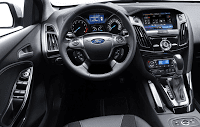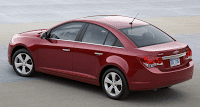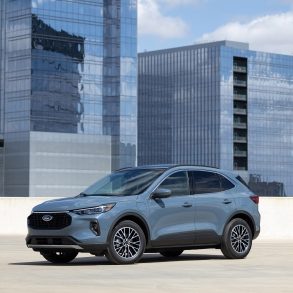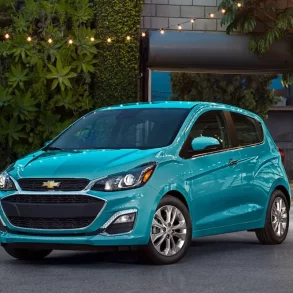 Ford Motor Company is about to come roaring out of Detroit’s North American International Auto Show with even more momentum than it had going in. General Motors, meanwhile, may not have PR on its side; but does have a nice flock of product to help win back some customers. Of course, it was the Toyota brand which sold the most vehicles in the United States last year. Honda, another Japanese company, had the second-best selling small car. And with talk constantly turning to small cars, how are Ford and GM going to compete?
Ford Motor Company is about to come roaring out of Detroit’s North American International Auto Show with even more momentum than it had going in. General Motors, meanwhile, may not have PR on its side; but does have a nice flock of product to help win back some customers. Of course, it was the Toyota brand which sold the most vehicles in the United States last year. Honda, another Japanese company, had the second-best selling small car. And with talk constantly turning to small cars, how are Ford and GM going to compete?
Ford’s most important NAIAS debut was the ’11 Ford Focus (click here for more images and details). Chevrolet, GM’s stalwart bow-tie brand, made us aware of the Chevrolet Cobalt’s successor, the Cruze, a long time ago. Details for that car can be seen here. The Focus, as we know it, has been around for a decade. Sure, it’s undergone some stylistic alterations and even the odd engineering switcheroo, but for the most part, the 2010 Ford Focus is way too much like the 2000 Ford Focus. Oh, it was fine for its time – if a little prone to recalls – but not fine for 2010. The Cobalt, meanwhile, was heralded as the car that’d make us all forget about the Chevrolet Cavalier. True, the Cavalier seems like a distant nightmare memory. But compared with its competitors from Japan and Korea, the Chevrolet Cobalt felt disconnected; more of a larger alternative for people who drove cars from the class below.
Does the automotive media’s disgust with the current Ford Focus and Chevrolet Cobalt translate to real world Sales Stats poverty? What will the 2011 Focus and Cruze have to do to be considered great, not just in the hands of an enthusiast, but in the Marketplace? Most importantly, can the Chevrolet Cruze and Ford Focus replace the Honda Civic, Toyota Corolla, and Mazda 3 as obvious choices for small car buyers in North America? Some of the answers are available in the Numbers analyzed below.
Problem number one for the Cruze and Focus is the invincible might of a bunch of cars from Japan and Korea. To name just a few: the Hyundai Elantra (103,269 U.S. sales in ’09), the Mazda 3 and its 93,466 ’09 customers, the Honda Civic and all 259,722 of its U.S. sales from 2009, and the Toyota Corolla’s gigantic chunk of 296,874 U.S. sales from last year (including the Matrix). Don’t forget Kia, which supplied 105,063 small car sales for itself in the United States in the form of Spectra, Forte, and Soul. This doesn’t take into account lesser figures like the Nissan Sentra, Mitsubishi Lancer, Subaru Impreza, and Suzuki’s SX4. Or a German competitor like the Volkswagen Golf or an Italian-American from Fiat called by the name of Dodge Caliber. Nearly all of these cars suffered declining sales in 2009. If the market recovers at all, Corolla sales will rise and a new Civic could result in a big jump at Honda.
Still, was the situation oh-so-terrible at Ford and Chevrolet last year? Cobalt sales were down 44.3% but still came in at 104,724. Add in the Saturn Astra and Pontiac’s duo of G5 and Vibe and GM sold over 150,000 cars in this size category in America alone. Across town, Ford’s calculators show Focus sales to have dropped 18.1% from ’08 yet the total still landed at 160,433. Were/Are the Focus and Cobalt as bad as we were led to believe? Take problem number two into account: how much were people paying for a new Ford Focus or Chevrolet Cobalt? Detroit’s profits aren’t simply a multiplication of a car’s MSRP x units sold. Besides, out of the cash earned, GM probably had to pay for some 44-year old unemployed guy’s appointment with a doctor.
We still have to give Chevrolet and Ford credit for their ability to sell undesirable cars. Regardless of what you may’ve heard over the last few years about their pitiful small car offerings, an awful lot of people were still paying money for those pitiful small car offerings. If only the margins on these small cars weren’t so thin to begin with, you would assume Ford and GM were making lots of dough off these cars.
It’s a fair guess that a gorgeous ‘11 Ford Focus won’t cannibalize sales of the Toyota Corolla. Even if Chevrolet’s Cruze debuts to rave reviews in Car&Driver or InsideLine or AutoBlog, Honda Civic sales probably won’t fall off a cliff. More likely, the forgettable (and currently not so successful) small cars from smaller manufacturers may struggle against a Corolla/Civic/Cruze/Focus quartet that could swallow up more than 900,000 or 1,000,000 U.S. sales in 2011. Imagine fuel prices rising, people fleeing their V6-engined Honda Accords, Toyota Camrys, Chevrolet Malibus, and Ford Fusions. It’s more than reasonable to consider the best-selling car in America would be one of these four smaller automobiles.
For the 2011 Ford Focus or the Chevrolet Cruze not to be considered failures in my book on GoodCarBadCar.net, one thing must occur. Cruze sales must exceed 188,045. That’s how many Cobalts Chevrolet sold in 2008. With an economy on the mend, internal competitors extinguished, and a much better car, sales have to match that of an old dog. At Ford, 195,823 is the magic number. Ford sold that many Foci in 2008. Six-digit sales figures beginning a 2 could start Ford and Chevy on the road to small car success.












This new Focus makes Cruze look over rated
The new Focus or the new Cruze make the Corolla or new Civic overated. The 2012 Honda CIvic is one UGLY car!
It's a shame that the Mazda 3 does not sell at nearly the volume of Honda or Toyota, as it is in my opinion far superior.
I do not understand the obsession with Corollas as that would be my last choice.